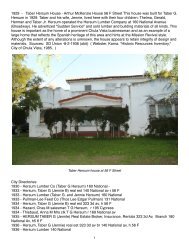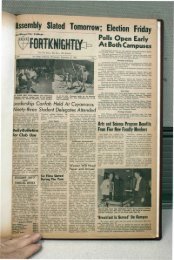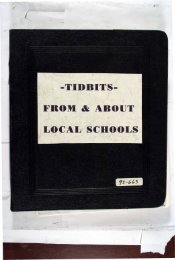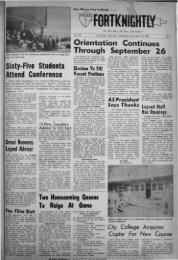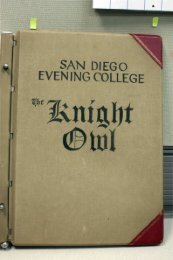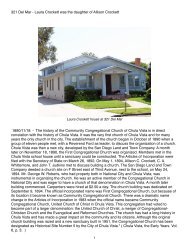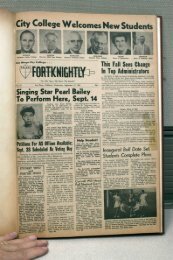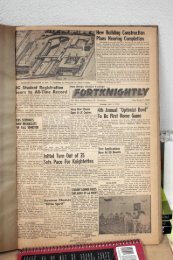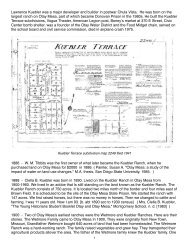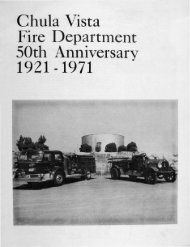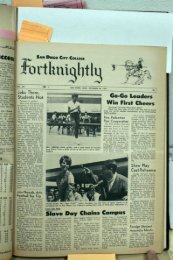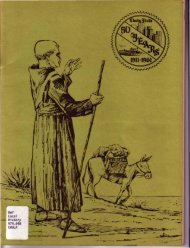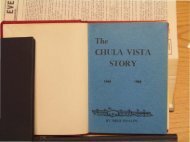doc241 - Schoenherr Home Page in Sunny Chula Vista
doc241 - Schoenherr Home Page in Sunny Chula Vista
doc241 - Schoenherr Home Page in Sunny Chula Vista
Create successful ePaper yourself
Turn your PDF publications into a flip-book with our unique Google optimized e-Paper software.
complished. As each of the conspirators came out of the house <strong>in</strong> the early morn<strong>in</strong>g he<br />
was lassoed, and all were taken a little distance from town, where it was proposed to<br />
shoot them. They expressed a desire to be allowed to die as Christians, to confess to<br />
the priest, and receive the sacrament. This request was granted; the priest heard the<br />
confessions of each, and adm<strong>in</strong>istered the rites of the church. A trench of suitable depth<br />
was then dug, and the Indians made to kneel close beside it. Then on be<strong>in</strong>g shot, each<br />
fell <strong>in</strong>to the ditch, where he was buried. Eight or ten Indians were executed at this time.<br />
"While these proceed<strong>in</strong>gs were tak<strong>in</strong>g place a messenger was sent to one of the<br />
Boston hide-ships ly<strong>in</strong>g <strong>in</strong> port, request<strong>in</strong>g<br />
<strong>Page</strong> 186<br />
that a cannon might be loaned to the town, to assist <strong>in</strong> its defense. The cannon was<br />
sent over, with a suitable supply of ammunition. At night a party of citizens visited the<br />
spot where the Indian spy was to appear, and succeeded <strong>in</strong> captur<strong>in</strong>g him. He steadily<br />
refused to confess, though assured that he would soon die, as his friends had done before<br />
him. One of his ears was cut off, and he was given to understand that the other one<br />
would follow, and that he would be mutilated little by little until he made the statement<br />
required of him, whereupon, his resolution gave way, and he made a confession <strong>in</strong>dicat<strong>in</strong>g<br />
where the Indians were encamped, and tell<strong>in</strong>g all that he knew.<br />
"After the spy had divulged all he knew, he was shot without further ceremony, he<br />
be<strong>in</strong>g an unconverted Indian and not desir<strong>in</strong>g the services of a priest. The next day the<br />
citizens went out <strong>in</strong> force, found and surprised the Indians, and engaged them <strong>in</strong> battle;<br />
numbers of them were killed, but none of the Californians."<br />
In December, 1846, soon after the battle of San Pasqual, eleven men were killed<br />
<strong>in</strong> an Indian upris<strong>in</strong>g at Pauma. Their names were: Sergeant Francisco Basualdo, José<br />
M. Alvarado, Manuel Serrano, Ramon Aguilar, an old man known as "Dom<strong>in</strong>guito" but<br />
whose name was Dom<strong>in</strong>guez, Santiago Osuna, José Lopez, Santos Alipás, Estaquio<br />
Ruiz, Juan de la Cruz, and a New Mexican whose name is not known.<br />
These men were Mexican rangers and they were taken prisoners by the Pauma<br />
Indians, whose chief, at the time, was Manuelito. It is not known why the Indians captured<br />
them, but it is possible they had some grievance on account of past ill treatment.<br />
The Indians were at first <strong>in</strong> doubt what to do with their prisoners; then came Bill Marshall,<br />
a white man liv<strong>in</strong>g with a neighbor<strong>in</strong>g tribe, who will be mentioned aga<strong>in</strong> later, and<br />
told the Indians that, s<strong>in</strong>ce the Mexicans and Americans were at war, it would please the<br />
latter if they would execute these prisoners. This bad advice was taken and the men put<br />
to death. Manuelito later became general over nearly all the Indians liv<strong>in</strong>g <strong>in</strong> San Diego<br />
county. He was a man of f<strong>in</strong>e character and had many friends, among the warmest of<br />
whom were some of the relatives of the murdered Spaniards.<br />
Antonio Garra, a San Luis Rey Indian, received a fair education at the San Luis<br />
Rey Mission. He was a man of energy, determ<strong>in</strong>ation, and <strong>in</strong>fluence. He was chief of the<br />
tribe resid<strong>in</strong>g <strong>in</strong> the neighborhood of Warner's Ranch, i. e., the Cupeños, and had large<br />
herds of cattle and horses.<br />
The first sheriff of San Diego County, Agost<strong>in</strong> Haraszthy, conceived it to be his<br />
duty to collect taxes on the live stock of the Indians, and <strong>in</strong> his effort to do so came <strong>in</strong>to<br />
conflict with Garra. The Indians also claimed the whites were settl<strong>in</strong>g on their lands and<br />
try<strong>in</strong>g to take the hot spr<strong>in</strong>gs away from them. Liv<strong>in</strong>g with Garra's tribe at this time was<br />
one William Mar-



